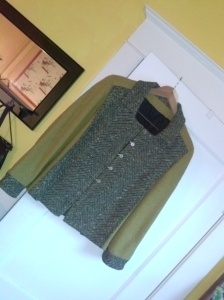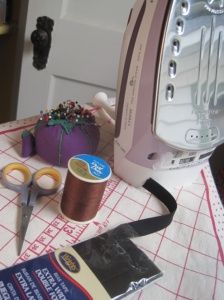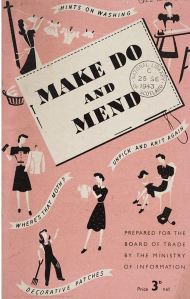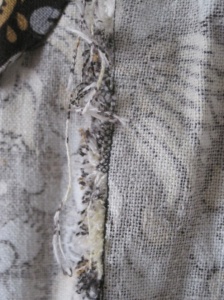My mother was an excellent seamstress when I was in high school. I didn’t have much incentive to learn to sew myself since I could never make anything that was as high quality as what my mother could produce. It was a love of vintage clothing that eventually brought me into the world of sewing decades later. I was walking by St. Paul’s awesome fabric store Treadle Yard Goods and noticed a 50s style dress that bowled me over. It turned out to be the diamond dress pattern from the retro pattern company Decades of Style. I went in and bought the pattern even though I didn’t even own a sewing machine. I’m now on my second sewing machine (a vintage Bernina) and I have accumulated a mini-library of vintage patterns (ironically, I still haven’t made that diamond dress!).
Learning to sew has expanded what vintage items I can buy and successfully wear. I regularly make routine alterations such as hemming, letting out or taking in seams. I think of these alterations as uncontroversial. I never even cut the hem when I take up a skirt so that if the next owner is taller, she’ll have something to work with. And I normally avoid trimming seam allowances I’ve taken in for the same reason.
Where things get a little more ethically uncomfortable for me is when I’m permanently altering the garment in ways that it can’t return to its original state. I’ve altered a maxi into a mini. And if I really love a long vintage skirt that has a tiny waist (I comfort myself with the thought that they wore girdles back in those days, right?), I’ve cut off the waistband and re-sewn it with a contour waistline (mark the new waist-line using a pattern if you’re trying this at home). The contour style waistband-less skirt is not authentic to the time period, but it fits me comfortably.
And re-shaping a waist is one thing, but what about a complete re-fashion? I adore Charity Shop Chic or Jillian Owens’ blog Refashionista where fantastic seamstresses take thrift store finds and makes them into cute clothes for a night out on the town. They, of course, work with cast-off clothing. What about cutting into a vintage garment and refashioning it into something more contemporary? I’m probably treading on vintage ethical thin ice, but I’ll admit I’ve done it. I love 1950s novelty print skirts like this brown one below, but they usually have the tiny waists I was referring to above.
This leads me to the story of my first novelty skirt I found. It was a lavender novelty print skirt with a 23-inch waist. When I cut off the waistband in order to create a new one and shorten the skirt, I discovered over 2 yards of fabric tightly gathered in that tiny waistband! I ultimately decided not to make it into another skirt – I had enough fabric for an entire dress and made the one you see below.

And the jacket at the top of this blog post? The herringbone section made up a bulky skirt that I watched hang unloved in a local vintage shop for two years before I bought it and turned it into the 1960s Vogue jacket pattern.
But should I have made the cuts and re-worked the skirts?
I never really thought about the ethics of altering vintage until I had a conversation with a Ph.D. student from the University of Minnesota’s Design-Apparel Studies program. With her training in textile conservation, she brought up how altering vintage clothing posed a real dilemma – the conservationist in her wanted to leave the clothes un-molested, but the fashionista wanted to alter and wear. Re-fashioning old clothing to re-shape it into new styles is an old practice. Patricia Allerston in Reconstructing the Second-Hand Clothes Trade in Sixteenth- and Seventeen-Century Venice reasoned that there are few surviving examples of Italian Renaissance clothing because the fabric remained valuable after a particular style faded, and old garments were re-worked into new ones.
So does that mean (gulp) that when I remove a genuine 1950s tiny waistband that I’m contributing to a world where no one will know what these waistbands look like or how small 50s young women once were?
It’s possible. That’s why I’ve felt a little nervous about my past vintage refashions. Yet, I will say that losing examples of 1950s skirts seems less probable than the loss of surviving 16th- and 17th-century Venetian dresses. The Venetian textiles remained valuable because they were rare, painstaking handcrafted by expert weavers, and so they were sewn into something else. The 1950s fabrics are high quality but mass-produced – not the same type of high quality as Venetian brocades. Finding examples today of 1950s textiles is thankfully not that difficult. Moreover, because we are more fascinated by our recent past than the Renaissance Venetians probably were, people keep their high quality old clothes. Museums and historical societies regularly collect antique garments – from haute couture to everyday wear – as part of their conservation efforts. And today’s grand dames of fashion are willing to ensure that the iconic clothing of past decades is conserved (for example, I recently watched the documentary Iris about Iris Apfel, who was donating her clothing to the Peabody Essex Museum).
I definitely haven’t taken the ethical high road of conservationism when it comes to making my vintage clothes work for today. I do keep alterations to a minimum rather than frequently engaging in a full-scale re-fashioning. And I should note that the designer garments I own are off-limits for anything but hemming – their value is retained through minimal to no change. But in the end I rationalize that re-fashioning old styles into new garments is also a part of our Western heritage and is a tradition that I’m carrying on, for better or for worse.


















